HEA610 - Literature Review: Challenges in Asthma Management in Elderly
VerifiedAdded on 2023/06/10
|38
|12972
|119
Literature Review
AI Summary
This literature review examines the challenges in managing asthma among the elderly population, a group facing increased risks of morbidity and mortality due to the pathophysiology of aging, under-diagnosis, and complex care requirements. The review addresses the research question: "How can proper management of asthma be achieved in the elderly to reduce symptoms?" It includes a systematic search of databases like Medline, CINAHL, PubMed, and EMBASE, using specific inclusion and exclusion criteria to analyze relevant research articles published after 2009. The review identifies key challenges such as misdiagnosis due to mimicking cardiovascular diseases, the impact of comorbidities, and difficulties in implementing effective interventions. The findings contribute to understanding the range of interventions applicable to elderly patients and the factors that increase management challenges, ultimately aiming to improve clinical practice and reduce the health burden associated with asthma in older adults. Desklib provides access to this and other solved assignments for students.
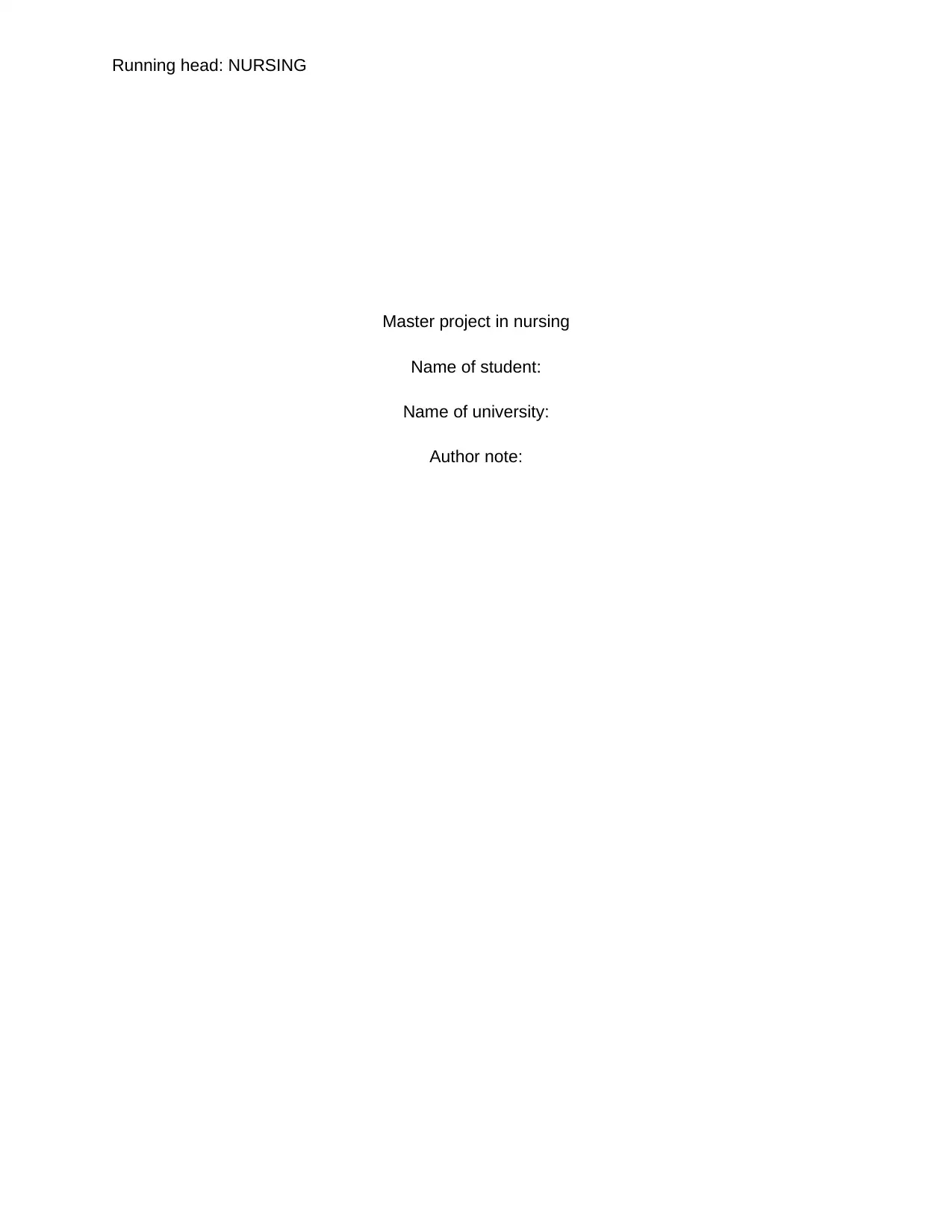
Running head: NURSING
Master project in nursing
Name of student:
Name of university:
Author note:
Master project in nursing
Name of student:
Name of university:
Author note:
Paraphrase This Document
Need a fresh take? Get an instant paraphrase of this document with our AI Paraphraser
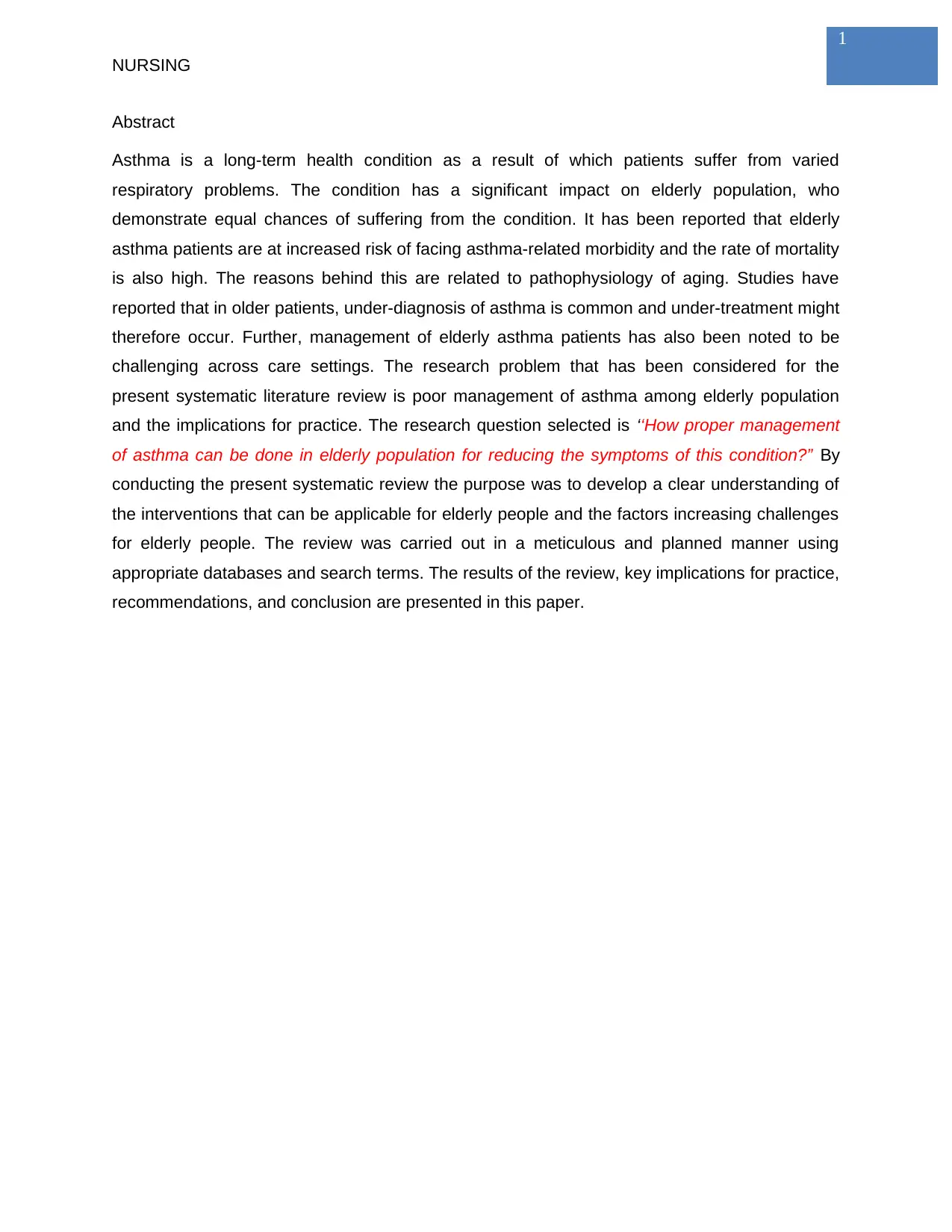
1
NURSING
Abstract
Asthma is a long-term health condition as a result of which patients suffer from varied
respiratory problems. The condition has a significant impact on elderly population, who
demonstrate equal chances of suffering from the condition. It has been reported that elderly
asthma patients are at increased risk of facing asthma-related morbidity and the rate of mortality
is also high. The reasons behind this are related to pathophysiology of aging. Studies have
reported that in older patients, under-diagnosis of asthma is common and under-treatment might
therefore occur. Further, management of elderly asthma patients has also been noted to be
challenging across care settings. The research problem that has been considered for the
present systematic literature review is poor management of asthma among elderly population
and the implications for practice. The research question selected is ‘‘How proper management
of asthma can be done in elderly population for reducing the symptoms of this condition?” By
conducting the present systematic review the purpose was to develop a clear understanding of
the interventions that can be applicable for elderly people and the factors increasing challenges
for elderly people. The review was carried out in a meticulous and planned manner using
appropriate databases and search terms. The results of the review, key implications for practice,
recommendations, and conclusion are presented in this paper.
NURSING
Abstract
Asthma is a long-term health condition as a result of which patients suffer from varied
respiratory problems. The condition has a significant impact on elderly population, who
demonstrate equal chances of suffering from the condition. It has been reported that elderly
asthma patients are at increased risk of facing asthma-related morbidity and the rate of mortality
is also high. The reasons behind this are related to pathophysiology of aging. Studies have
reported that in older patients, under-diagnosis of asthma is common and under-treatment might
therefore occur. Further, management of elderly asthma patients has also been noted to be
challenging across care settings. The research problem that has been considered for the
present systematic literature review is poor management of asthma among elderly population
and the implications for practice. The research question selected is ‘‘How proper management
of asthma can be done in elderly population for reducing the symptoms of this condition?” By
conducting the present systematic review the purpose was to develop a clear understanding of
the interventions that can be applicable for elderly people and the factors increasing challenges
for elderly people. The review was carried out in a meticulous and planned manner using
appropriate databases and search terms. The results of the review, key implications for practice,
recommendations, and conclusion are presented in this paper.
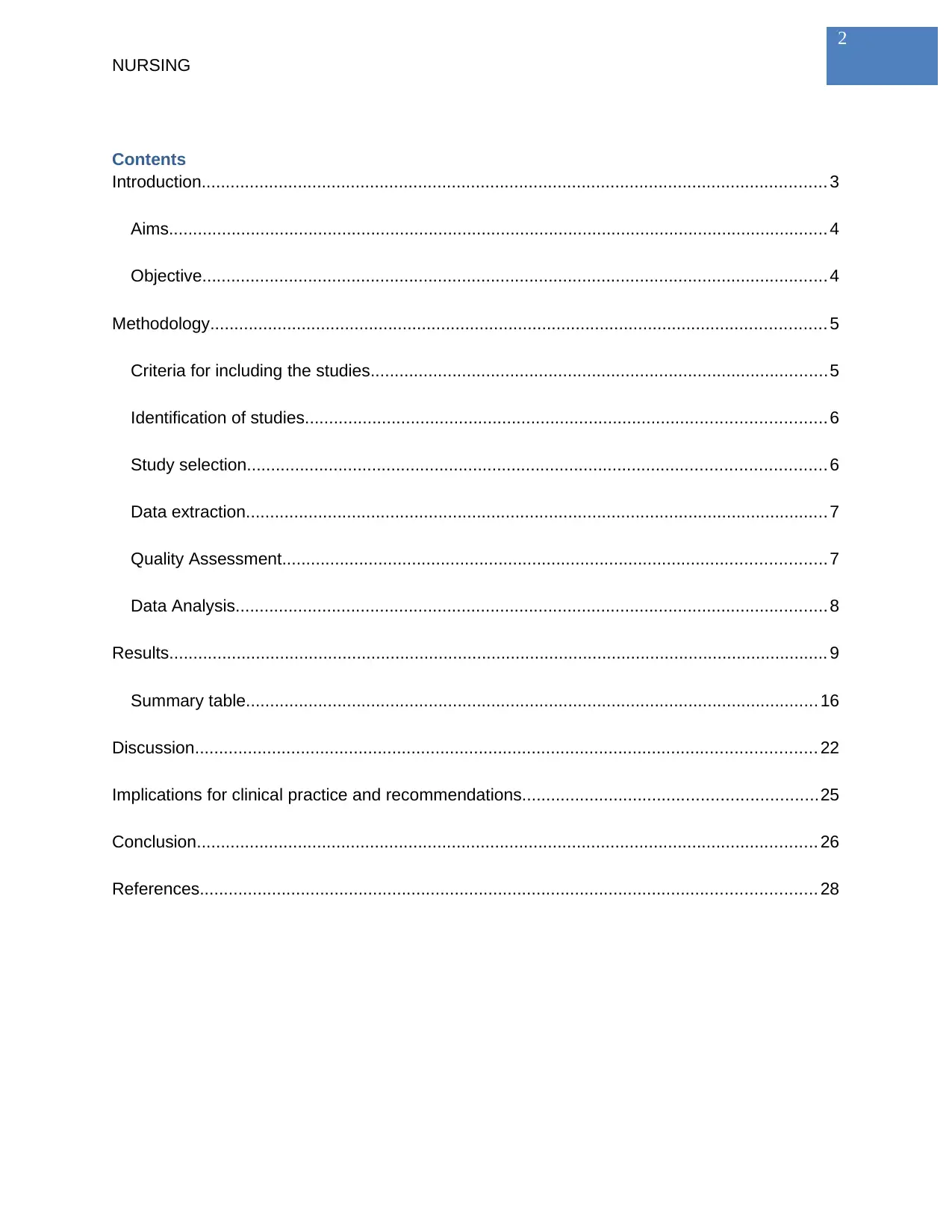
2
NURSING
Contents
Introduction.................................................................................................................................. 3
Aims......................................................................................................................................... 4
Objective.................................................................................................................................. 4
Methodology................................................................................................................................ 5
Criteria for including the studies...............................................................................................5
Identification of studies............................................................................................................ 6
Study selection........................................................................................................................ 6
Data extraction......................................................................................................................... 7
Quality Assessment................................................................................................................. 7
Data Analysis........................................................................................................................... 8
Results......................................................................................................................................... 9
Summary table....................................................................................................................... 16
Discussion................................................................................................................................. 22
Implications for clinical practice and recommendations.............................................................25
Conclusion................................................................................................................................. 26
References................................................................................................................................ 28
NURSING
Contents
Introduction.................................................................................................................................. 3
Aims......................................................................................................................................... 4
Objective.................................................................................................................................. 4
Methodology................................................................................................................................ 5
Criteria for including the studies...............................................................................................5
Identification of studies............................................................................................................ 6
Study selection........................................................................................................................ 6
Data extraction......................................................................................................................... 7
Quality Assessment................................................................................................................. 7
Data Analysis........................................................................................................................... 8
Results......................................................................................................................................... 9
Summary table....................................................................................................................... 16
Discussion................................................................................................................................. 22
Implications for clinical practice and recommendations.............................................................25
Conclusion................................................................................................................................. 26
References................................................................................................................................ 28
⊘ This is a preview!⊘
Do you want full access?
Subscribe today to unlock all pages.

Trusted by 1+ million students worldwide
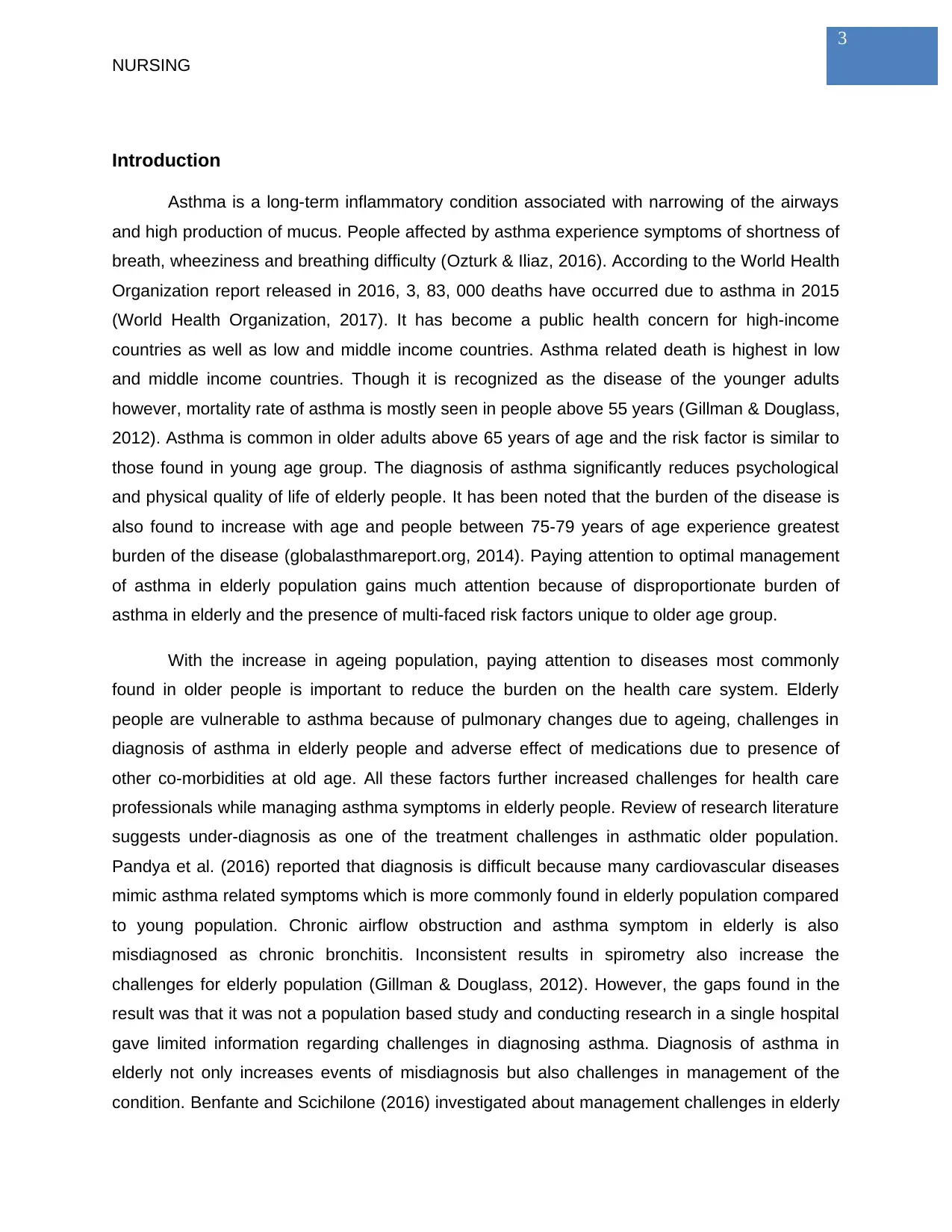
3
NURSING
Introduction
Asthma is a long-term inflammatory condition associated with narrowing of the airways
and high production of mucus. People affected by asthma experience symptoms of shortness of
breath, wheeziness and breathing difficulty (Ozturk & Iliaz, 2016). According to the World Health
Organization report released in 2016, 3, 83, 000 deaths have occurred due to asthma in 2015
(World Health Organization, 2017). It has become a public health concern for high-income
countries as well as low and middle income countries. Asthma related death is highest in low
and middle income countries. Though it is recognized as the disease of the younger adults
however, mortality rate of asthma is mostly seen in people above 55 years (Gillman & Douglass,
2012). Asthma is common in older adults above 65 years of age and the risk factor is similar to
those found in young age group. The diagnosis of asthma significantly reduces psychological
and physical quality of life of elderly people. It has been noted that the burden of the disease is
also found to increase with age and people between 75-79 years of age experience greatest
burden of the disease (globalasthmareport.org, 2014). Paying attention to optimal management
of asthma in elderly population gains much attention because of disproportionate burden of
asthma in elderly and the presence of multi-faced risk factors unique to older age group.
With the increase in ageing population, paying attention to diseases most commonly
found in older people is important to reduce the burden on the health care system. Elderly
people are vulnerable to asthma because of pulmonary changes due to ageing, challenges in
diagnosis of asthma in elderly people and adverse effect of medications due to presence of
other co-morbidities at old age. All these factors further increased challenges for health care
professionals while managing asthma symptoms in elderly people. Review of research literature
suggests under-diagnosis as one of the treatment challenges in asthmatic older population.
Pandya et al. (2016) reported that diagnosis is difficult because many cardiovascular diseases
mimic asthma related symptoms which is more commonly found in elderly population compared
to young population. Chronic airflow obstruction and asthma symptom in elderly is also
misdiagnosed as chronic bronchitis. Inconsistent results in spirometry also increase the
challenges for elderly population (Gillman & Douglass, 2012). However, the gaps found in the
result was that it was not a population based study and conducting research in a single hospital
gave limited information regarding challenges in diagnosing asthma. Diagnosis of asthma in
elderly not only increases events of misdiagnosis but also challenges in management of the
condition. Benfante and Scichilone (2016) investigated about management challenges in elderly
NURSING
Introduction
Asthma is a long-term inflammatory condition associated with narrowing of the airways
and high production of mucus. People affected by asthma experience symptoms of shortness of
breath, wheeziness and breathing difficulty (Ozturk & Iliaz, 2016). According to the World Health
Organization report released in 2016, 3, 83, 000 deaths have occurred due to asthma in 2015
(World Health Organization, 2017). It has become a public health concern for high-income
countries as well as low and middle income countries. Asthma related death is highest in low
and middle income countries. Though it is recognized as the disease of the younger adults
however, mortality rate of asthma is mostly seen in people above 55 years (Gillman & Douglass,
2012). Asthma is common in older adults above 65 years of age and the risk factor is similar to
those found in young age group. The diagnosis of asthma significantly reduces psychological
and physical quality of life of elderly people. It has been noted that the burden of the disease is
also found to increase with age and people between 75-79 years of age experience greatest
burden of the disease (globalasthmareport.org, 2014). Paying attention to optimal management
of asthma in elderly population gains much attention because of disproportionate burden of
asthma in elderly and the presence of multi-faced risk factors unique to older age group.
With the increase in ageing population, paying attention to diseases most commonly
found in older people is important to reduce the burden on the health care system. Elderly
people are vulnerable to asthma because of pulmonary changes due to ageing, challenges in
diagnosis of asthma in elderly people and adverse effect of medications due to presence of
other co-morbidities at old age. All these factors further increased challenges for health care
professionals while managing asthma symptoms in elderly people. Review of research literature
suggests under-diagnosis as one of the treatment challenges in asthmatic older population.
Pandya et al. (2016) reported that diagnosis is difficult because many cardiovascular diseases
mimic asthma related symptoms which is more commonly found in elderly population compared
to young population. Chronic airflow obstruction and asthma symptom in elderly is also
misdiagnosed as chronic bronchitis. Inconsistent results in spirometry also increase the
challenges for elderly population (Gillman & Douglass, 2012). However, the gaps found in the
result was that it was not a population based study and conducting research in a single hospital
gave limited information regarding challenges in diagnosing asthma. Diagnosis of asthma in
elderly not only increases events of misdiagnosis but also challenges in management of the
condition. Benfante and Scichilone (2016) investigated about management challenges in elderly
Paraphrase This Document
Need a fresh take? Get an instant paraphrase of this document with our AI Paraphraser
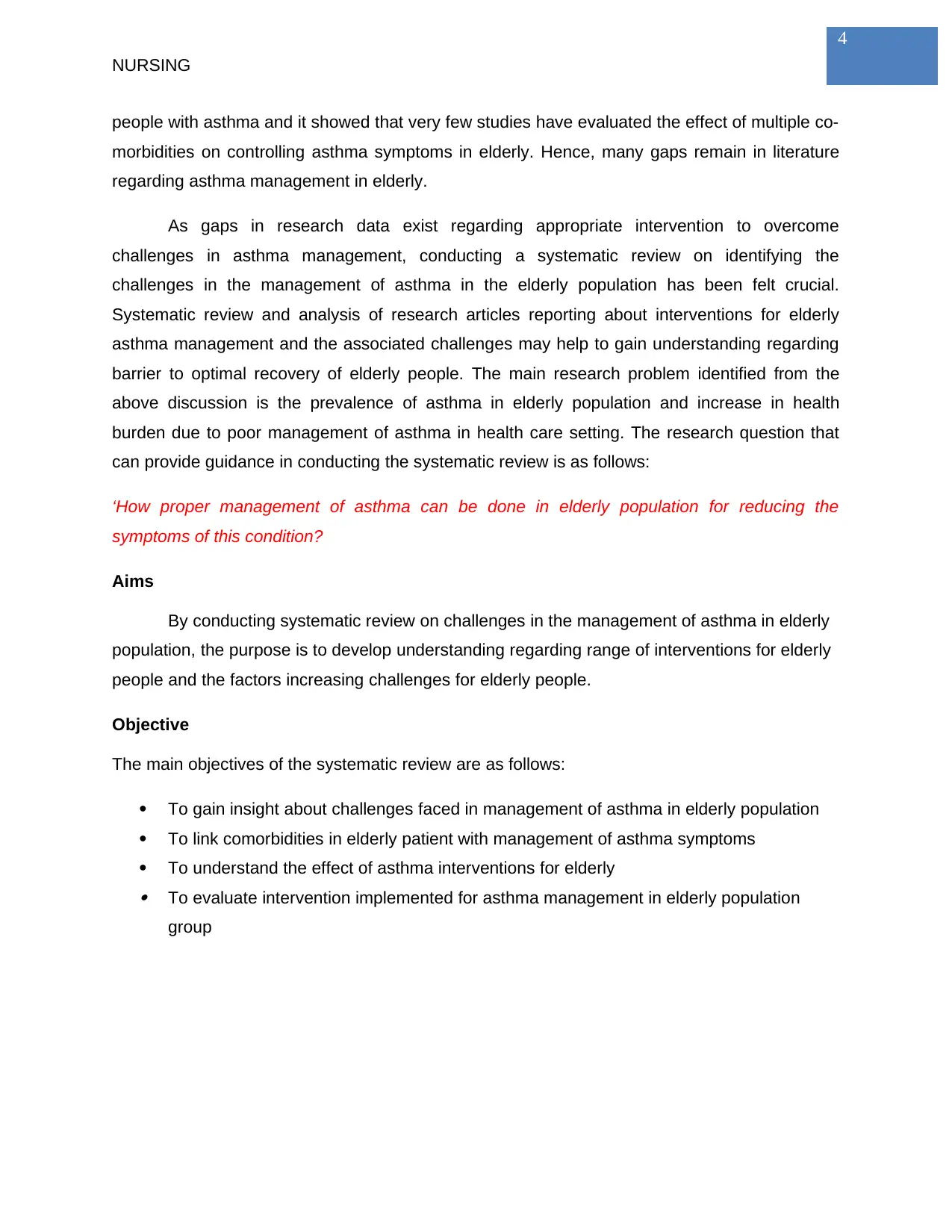
4
NURSING
people with asthma and it showed that very few studies have evaluated the effect of multiple co-
morbidities on controlling asthma symptoms in elderly. Hence, many gaps remain in literature
regarding asthma management in elderly.
As gaps in research data exist regarding appropriate intervention to overcome
challenges in asthma management, conducting a systematic review on identifying the
challenges in the management of asthma in the elderly population has been felt crucial.
Systematic review and analysis of research articles reporting about interventions for elderly
asthma management and the associated challenges may help to gain understanding regarding
barrier to optimal recovery of elderly people. The main research problem identified from the
above discussion is the prevalence of asthma in elderly population and increase in health
burden due to poor management of asthma in health care setting. The research question that
can provide guidance in conducting the systematic review is as follows:
‘How proper management of asthma can be done in elderly population for reducing the
symptoms of this condition?
Aims
By conducting systematic review on challenges in the management of asthma in elderly
population, the purpose is to develop understanding regarding range of interventions for elderly
people and the factors increasing challenges for elderly people.
Objective
The main objectives of the systematic review are as follows:
To gain insight about challenges faced in management of asthma in elderly population
To link comorbidities in elderly patient with management of asthma symptoms
To understand the effect of asthma interventions for elderly To evaluate intervention implemented for asthma management in elderly population
group
NURSING
people with asthma and it showed that very few studies have evaluated the effect of multiple co-
morbidities on controlling asthma symptoms in elderly. Hence, many gaps remain in literature
regarding asthma management in elderly.
As gaps in research data exist regarding appropriate intervention to overcome
challenges in asthma management, conducting a systematic review on identifying the
challenges in the management of asthma in the elderly population has been felt crucial.
Systematic review and analysis of research articles reporting about interventions for elderly
asthma management and the associated challenges may help to gain understanding regarding
barrier to optimal recovery of elderly people. The main research problem identified from the
above discussion is the prevalence of asthma in elderly population and increase in health
burden due to poor management of asthma in health care setting. The research question that
can provide guidance in conducting the systematic review is as follows:
‘How proper management of asthma can be done in elderly population for reducing the
symptoms of this condition?
Aims
By conducting systematic review on challenges in the management of asthma in elderly
population, the purpose is to develop understanding regarding range of interventions for elderly
people and the factors increasing challenges for elderly people.
Objective
The main objectives of the systematic review are as follows:
To gain insight about challenges faced in management of asthma in elderly population
To link comorbidities in elderly patient with management of asthma symptoms
To understand the effect of asthma interventions for elderly To evaluate intervention implemented for asthma management in elderly population
group
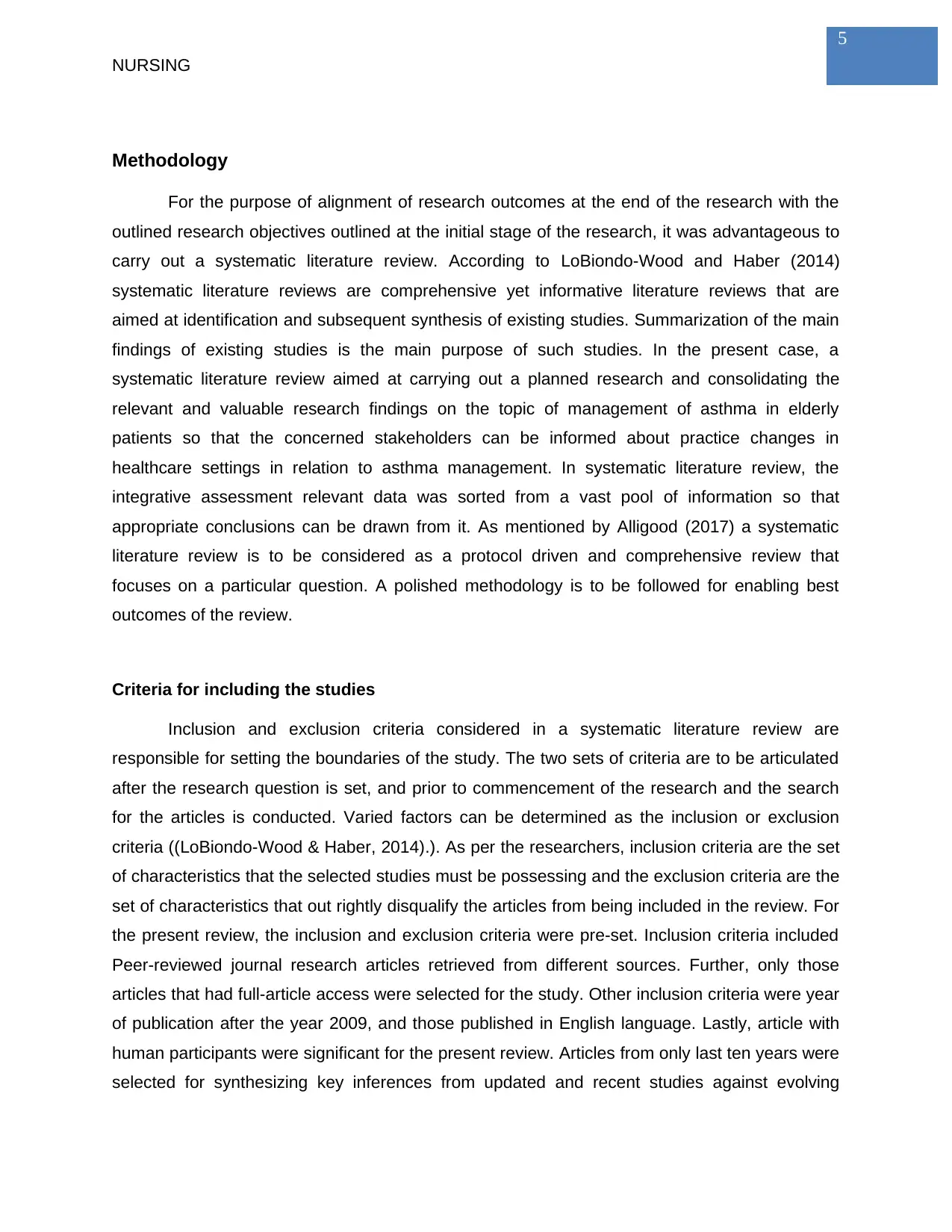
5
NURSING
Methodology
For the purpose of alignment of research outcomes at the end of the research with the
outlined research objectives outlined at the initial stage of the research, it was advantageous to
carry out a systematic literature review. According to LoBiondo-Wood and Haber (2014)
systematic literature reviews are comprehensive yet informative literature reviews that are
aimed at identification and subsequent synthesis of existing studies. Summarization of the main
findings of existing studies is the main purpose of such studies. In the present case, a
systematic literature review aimed at carrying out a planned research and consolidating the
relevant and valuable research findings on the topic of management of asthma in elderly
patients so that the concerned stakeholders can be informed about practice changes in
healthcare settings in relation to asthma management. In systematic literature review, the
integrative assessment relevant data was sorted from a vast pool of information so that
appropriate conclusions can be drawn from it. As mentioned by Alligood (2017) a systematic
literature review is to be considered as a protocol driven and comprehensive review that
focuses on a particular question. A polished methodology is to be followed for enabling best
outcomes of the review.
Criteria for including the studies
Inclusion and exclusion criteria considered in a systematic literature review are
responsible for setting the boundaries of the study. The two sets of criteria are to be articulated
after the research question is set, and prior to commencement of the research and the search
for the articles is conducted. Varied factors can be determined as the inclusion or exclusion
criteria ((LoBiondo-Wood & Haber, 2014).). As per the researchers, inclusion criteria are the set
of characteristics that the selected studies must be possessing and the exclusion criteria are the
set of characteristics that out rightly disqualify the articles from being included in the review. For
the present review, the inclusion and exclusion criteria were pre-set. Inclusion criteria included
Peer-reviewed journal research articles retrieved from different sources. Further, only those
articles that had full-article access were selected for the study. Other inclusion criteria were year
of publication after the year 2009, and those published in English language. Lastly, article with
human participants were significant for the present review. Articles from only last ten years were
selected for synthesizing key inferences from updated and recent studies against evolving
NURSING
Methodology
For the purpose of alignment of research outcomes at the end of the research with the
outlined research objectives outlined at the initial stage of the research, it was advantageous to
carry out a systematic literature review. According to LoBiondo-Wood and Haber (2014)
systematic literature reviews are comprehensive yet informative literature reviews that are
aimed at identification and subsequent synthesis of existing studies. Summarization of the main
findings of existing studies is the main purpose of such studies. In the present case, a
systematic literature review aimed at carrying out a planned research and consolidating the
relevant and valuable research findings on the topic of management of asthma in elderly
patients so that the concerned stakeholders can be informed about practice changes in
healthcare settings in relation to asthma management. In systematic literature review, the
integrative assessment relevant data was sorted from a vast pool of information so that
appropriate conclusions can be drawn from it. As mentioned by Alligood (2017) a systematic
literature review is to be considered as a protocol driven and comprehensive review that
focuses on a particular question. A polished methodology is to be followed for enabling best
outcomes of the review.
Criteria for including the studies
Inclusion and exclusion criteria considered in a systematic literature review are
responsible for setting the boundaries of the study. The two sets of criteria are to be articulated
after the research question is set, and prior to commencement of the research and the search
for the articles is conducted. Varied factors can be determined as the inclusion or exclusion
criteria ((LoBiondo-Wood & Haber, 2014).). As per the researchers, inclusion criteria are the set
of characteristics that the selected studies must be possessing and the exclusion criteria are the
set of characteristics that out rightly disqualify the articles from being included in the review. For
the present review, the inclusion and exclusion criteria were pre-set. Inclusion criteria included
Peer-reviewed journal research articles retrieved from different sources. Further, only those
articles that had full-article access were selected for the study. Other inclusion criteria were year
of publication after the year 2009, and those published in English language. Lastly, article with
human participants were significant for the present review. Articles from only last ten years were
selected for synthesizing key inferences from updated and recent studies against evolving
⊘ This is a preview!⊘
Do you want full access?
Subscribe today to unlock all pages.

Trusted by 1+ million students worldwide
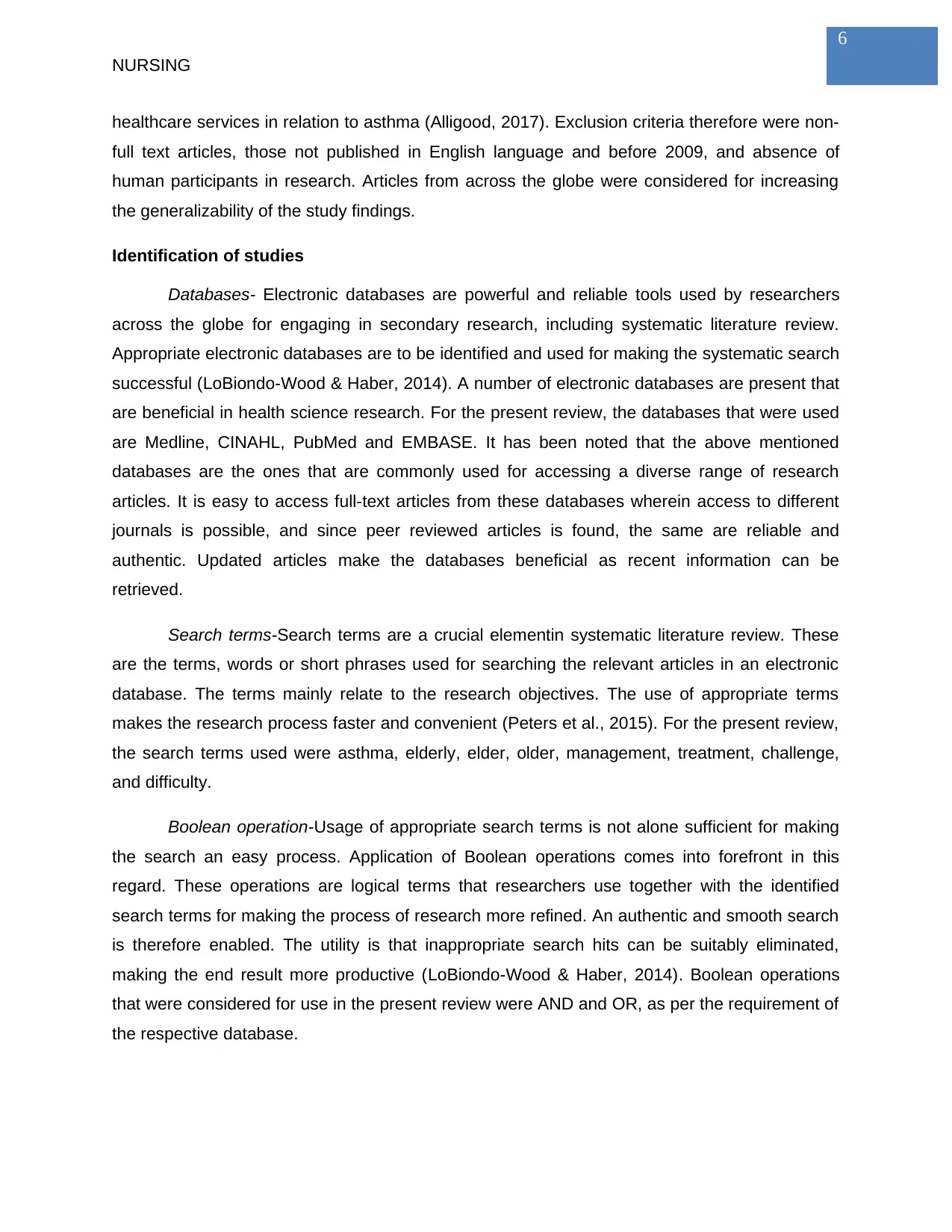
6
NURSING
healthcare services in relation to asthma (Alligood, 2017). Exclusion criteria therefore were non-
full text articles, those not published in English language and before 2009, and absence of
human participants in research. Articles from across the globe were considered for increasing
the generalizability of the study findings.
Identification of studies
Databases- Electronic databases are powerful and reliable tools used by researchers
across the globe for engaging in secondary research, including systematic literature review.
Appropriate electronic databases are to be identified and used for making the systematic search
successful (LoBiondo-Wood & Haber, 2014). A number of electronic databases are present that
are beneficial in health science research. For the present review, the databases that were used
are Medline, CINAHL, PubMed and EMBASE. It has been noted that the above mentioned
databases are the ones that are commonly used for accessing a diverse range of research
articles. It is easy to access full-text articles from these databases wherein access to different
journals is possible, and since peer reviewed articles is found, the same are reliable and
authentic. Updated articles make the databases beneficial as recent information can be
retrieved.
Search terms-Search terms are a crucial elementin systematic literature review. These
are the terms, words or short phrases used for searching the relevant articles in an electronic
database. The terms mainly relate to the research objectives. The use of appropriate terms
makes the research process faster and convenient (Peters et al., 2015). For the present review,
the search terms used were asthma, elderly, elder, older, management, treatment, challenge,
and difficulty.
Boolean operation-Usage of appropriate search terms is not alone sufficient for making
the search an easy process. Application of Boolean operations comes into forefront in this
regard. These operations are logical terms that researchers use together with the identified
search terms for making the process of research more refined. An authentic and smooth search
is therefore enabled. The utility is that inappropriate search hits can be suitably eliminated,
making the end result more productive (LoBiondo-Wood & Haber, 2014). Boolean operations
that were considered for use in the present review were AND and OR, as per the requirement of
the respective database.
NURSING
healthcare services in relation to asthma (Alligood, 2017). Exclusion criteria therefore were non-
full text articles, those not published in English language and before 2009, and absence of
human participants in research. Articles from across the globe were considered for increasing
the generalizability of the study findings.
Identification of studies
Databases- Electronic databases are powerful and reliable tools used by researchers
across the globe for engaging in secondary research, including systematic literature review.
Appropriate electronic databases are to be identified and used for making the systematic search
successful (LoBiondo-Wood & Haber, 2014). A number of electronic databases are present that
are beneficial in health science research. For the present review, the databases that were used
are Medline, CINAHL, PubMed and EMBASE. It has been noted that the above mentioned
databases are the ones that are commonly used for accessing a diverse range of research
articles. It is easy to access full-text articles from these databases wherein access to different
journals is possible, and since peer reviewed articles is found, the same are reliable and
authentic. Updated articles make the databases beneficial as recent information can be
retrieved.
Search terms-Search terms are a crucial elementin systematic literature review. These
are the terms, words or short phrases used for searching the relevant articles in an electronic
database. The terms mainly relate to the research objectives. The use of appropriate terms
makes the research process faster and convenient (Peters et al., 2015). For the present review,
the search terms used were asthma, elderly, elder, older, management, treatment, challenge,
and difficulty.
Boolean operation-Usage of appropriate search terms is not alone sufficient for making
the search an easy process. Application of Boolean operations comes into forefront in this
regard. These operations are logical terms that researchers use together with the identified
search terms for making the process of research more refined. An authentic and smooth search
is therefore enabled. The utility is that inappropriate search hits can be suitably eliminated,
making the end result more productive (LoBiondo-Wood & Haber, 2014). Boolean operations
that were considered for use in the present review were AND and OR, as per the requirement of
the respective database.
Paraphrase This Document
Need a fresh take? Get an instant paraphrase of this document with our AI Paraphraser
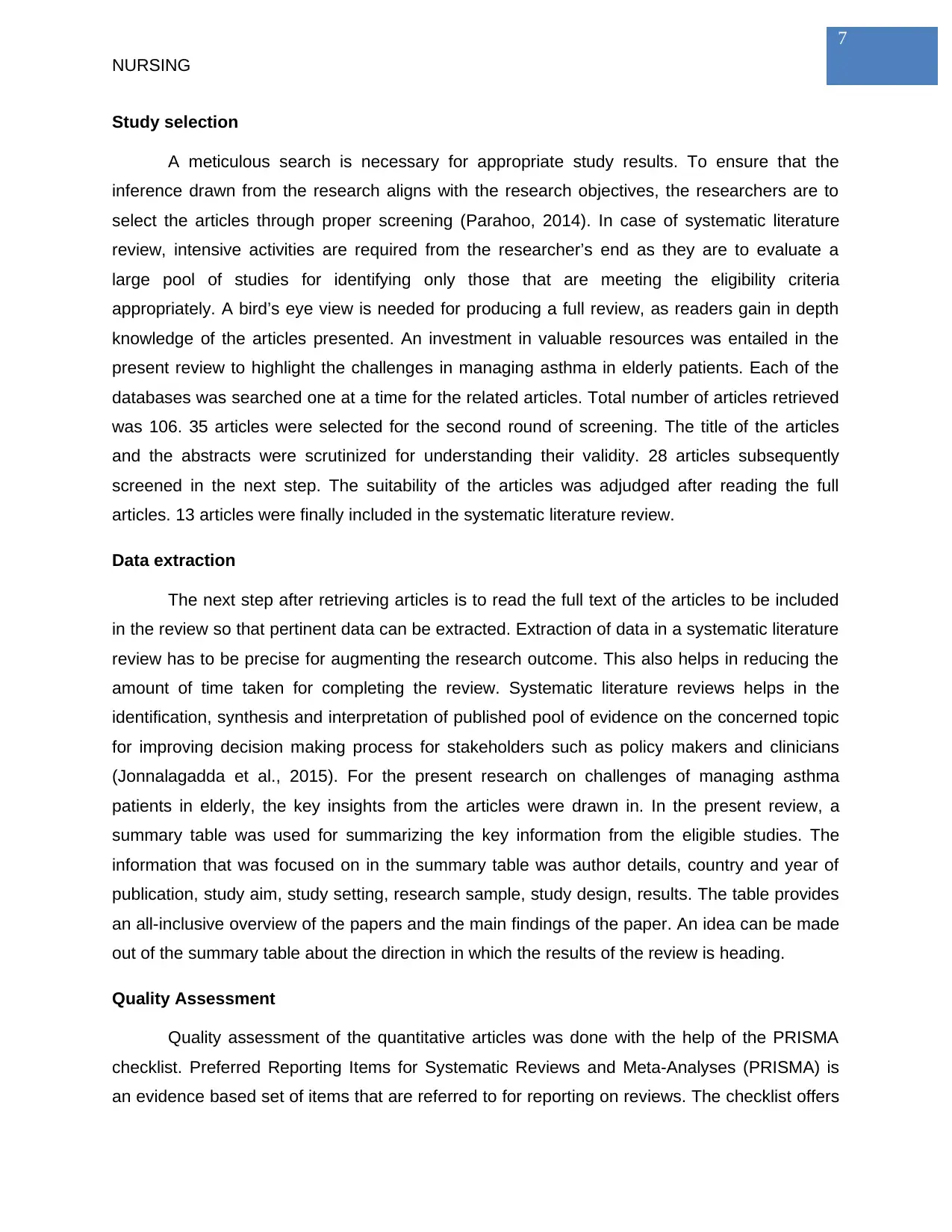
7
NURSING
Study selection
A meticulous search is necessary for appropriate study results. To ensure that the
inference drawn from the research aligns with the research objectives, the researchers are to
select the articles through proper screening (Parahoo, 2014). In case of systematic literature
review, intensive activities are required from the researcher’s end as they are to evaluate a
large pool of studies for identifying only those that are meeting the eligibility criteria
appropriately. A bird’s eye view is needed for producing a full review, as readers gain in depth
knowledge of the articles presented. An investment in valuable resources was entailed in the
present review to highlight the challenges in managing asthma in elderly patients. Each of the
databases was searched one at a time for the related articles. Total number of articles retrieved
was 106. 35 articles were selected for the second round of screening. The title of the articles
and the abstracts were scrutinized for understanding their validity. 28 articles subsequently
screened in the next step. The suitability of the articles was adjudged after reading the full
articles. 13 articles were finally included in the systematic literature review.
Data extraction
The next step after retrieving articles is to read the full text of the articles to be included
in the review so that pertinent data can be extracted. Extraction of data in a systematic literature
review has to be precise for augmenting the research outcome. This also helps in reducing the
amount of time taken for completing the review. Systematic literature reviews helps in the
identification, synthesis and interpretation of published pool of evidence on the concerned topic
for improving decision making process for stakeholders such as policy makers and clinicians
(Jonnalagadda et al., 2015). For the present research on challenges of managing asthma
patients in elderly, the key insights from the articles were drawn in. In the present review, a
summary table was used for summarizing the key information from the eligible studies. The
information that was focused on in the summary table was author details, country and year of
publication, study aim, study setting, research sample, study design, results. The table provides
an all-inclusive overview of the papers and the main findings of the paper. An idea can be made
out of the summary table about the direction in which the results of the review is heading.
Quality Assessment
Quality assessment of the quantitative articles was done with the help of the PRISMA
checklist. Preferred Reporting Items for Systematic Reviews and Meta-Analyses (PRISMA) is
an evidence based set of items that are referred to for reporting on reviews. The checklist offers
NURSING
Study selection
A meticulous search is necessary for appropriate study results. To ensure that the
inference drawn from the research aligns with the research objectives, the researchers are to
select the articles through proper screening (Parahoo, 2014). In case of systematic literature
review, intensive activities are required from the researcher’s end as they are to evaluate a
large pool of studies for identifying only those that are meeting the eligibility criteria
appropriately. A bird’s eye view is needed for producing a full review, as readers gain in depth
knowledge of the articles presented. An investment in valuable resources was entailed in the
present review to highlight the challenges in managing asthma in elderly patients. Each of the
databases was searched one at a time for the related articles. Total number of articles retrieved
was 106. 35 articles were selected for the second round of screening. The title of the articles
and the abstracts were scrutinized for understanding their validity. 28 articles subsequently
screened in the next step. The suitability of the articles was adjudged after reading the full
articles. 13 articles were finally included in the systematic literature review.
Data extraction
The next step after retrieving articles is to read the full text of the articles to be included
in the review so that pertinent data can be extracted. Extraction of data in a systematic literature
review has to be precise for augmenting the research outcome. This also helps in reducing the
amount of time taken for completing the review. Systematic literature reviews helps in the
identification, synthesis and interpretation of published pool of evidence on the concerned topic
for improving decision making process for stakeholders such as policy makers and clinicians
(Jonnalagadda et al., 2015). For the present research on challenges of managing asthma
patients in elderly, the key insights from the articles were drawn in. In the present review, a
summary table was used for summarizing the key information from the eligible studies. The
information that was focused on in the summary table was author details, country and year of
publication, study aim, study setting, research sample, study design, results. The table provides
an all-inclusive overview of the papers and the main findings of the paper. An idea can be made
out of the summary table about the direction in which the results of the review is heading.
Quality Assessment
Quality assessment of the quantitative articles was done with the help of the PRISMA
checklist. Preferred Reporting Items for Systematic Reviews and Meta-Analyses (PRISMA) is
an evidence based set of items that are referred to for reporting on reviews. The checklist offers
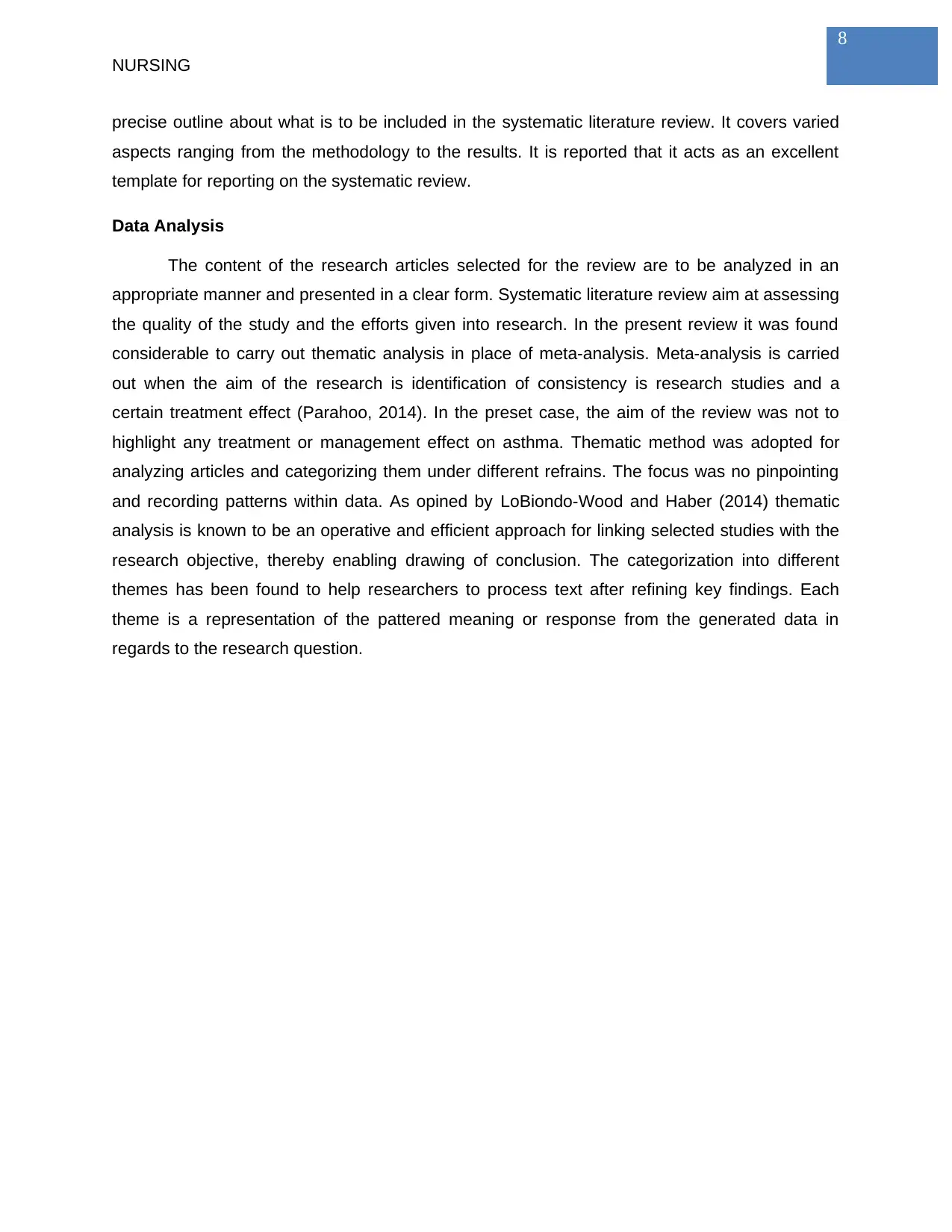
8
NURSING
precise outline about what is to be included in the systematic literature review. It covers varied
aspects ranging from the methodology to the results. It is reported that it acts as an excellent
template for reporting on the systematic review.
Data Analysis
The content of the research articles selected for the review are to be analyzed in an
appropriate manner and presented in a clear form. Systematic literature review aim at assessing
the quality of the study and the efforts given into research. In the present review it was found
considerable to carry out thematic analysis in place of meta-analysis. Meta-analysis is carried
out when the aim of the research is identification of consistency is research studies and a
certain treatment effect (Parahoo, 2014). In the preset case, the aim of the review was not to
highlight any treatment or management effect on asthma. Thematic method was adopted for
analyzing articles and categorizing them under different refrains. The focus was no pinpointing
and recording patterns within data. As opined by LoBiondo-Wood and Haber (2014) thematic
analysis is known to be an operative and efficient approach for linking selected studies with the
research objective, thereby enabling drawing of conclusion. The categorization into different
themes has been found to help researchers to process text after refining key findings. Each
theme is a representation of the pattered meaning or response from the generated data in
regards to the research question.
NURSING
precise outline about what is to be included in the systematic literature review. It covers varied
aspects ranging from the methodology to the results. It is reported that it acts as an excellent
template for reporting on the systematic review.
Data Analysis
The content of the research articles selected for the review are to be analyzed in an
appropriate manner and presented in a clear form. Systematic literature review aim at assessing
the quality of the study and the efforts given into research. In the present review it was found
considerable to carry out thematic analysis in place of meta-analysis. Meta-analysis is carried
out when the aim of the research is identification of consistency is research studies and a
certain treatment effect (Parahoo, 2014). In the preset case, the aim of the review was not to
highlight any treatment or management effect on asthma. Thematic method was adopted for
analyzing articles and categorizing them under different refrains. The focus was no pinpointing
and recording patterns within data. As opined by LoBiondo-Wood and Haber (2014) thematic
analysis is known to be an operative and efficient approach for linking selected studies with the
research objective, thereby enabling drawing of conclusion. The categorization into different
themes has been found to help researchers to process text after refining key findings. Each
theme is a representation of the pattered meaning or response from the generated data in
regards to the research question.
⊘ This is a preview!⊘
Do you want full access?
Subscribe today to unlock all pages.

Trusted by 1+ million students worldwide
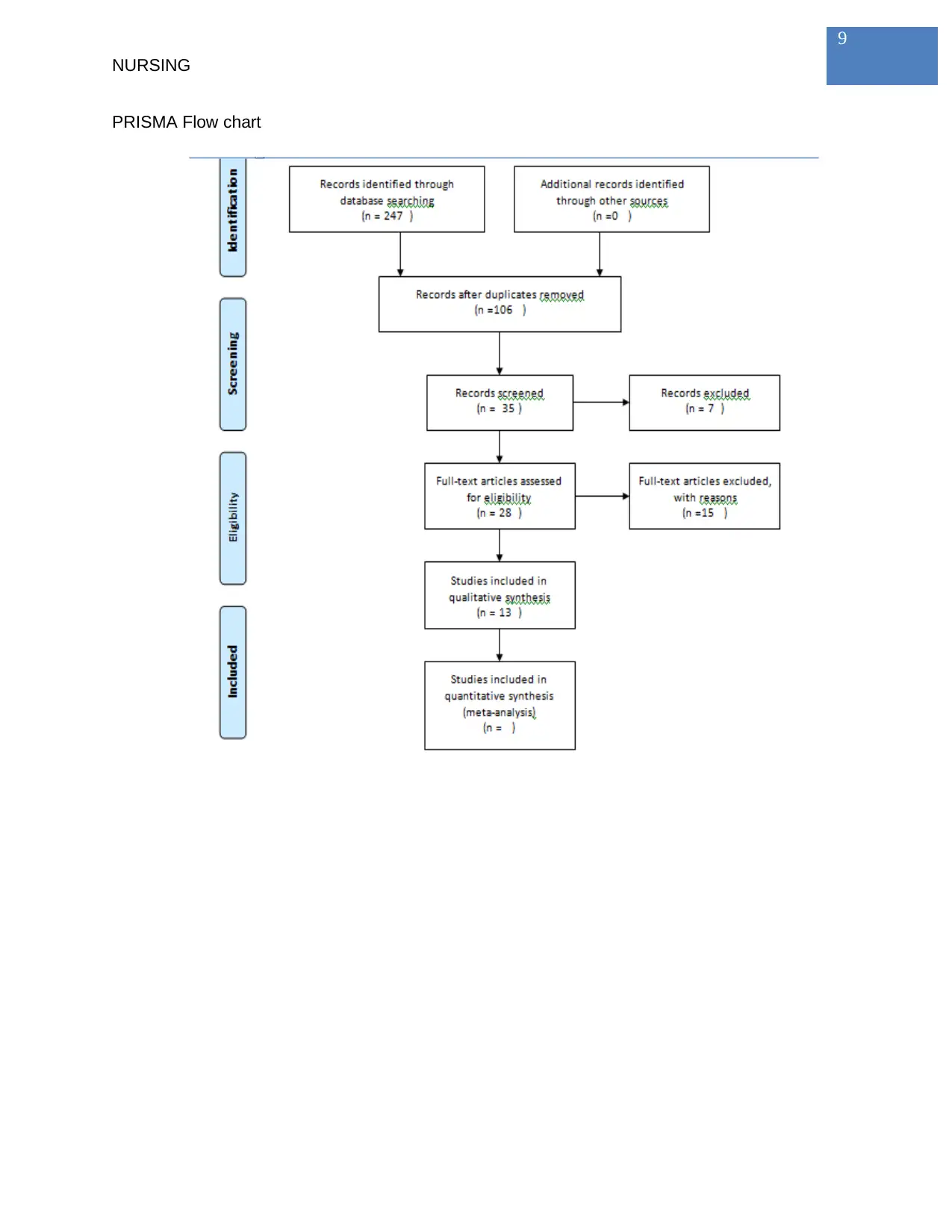
9
NURSING
PRISMA Flow chart
NURSING
PRISMA Flow chart
Paraphrase This Document
Need a fresh take? Get an instant paraphrase of this document with our AI Paraphraser
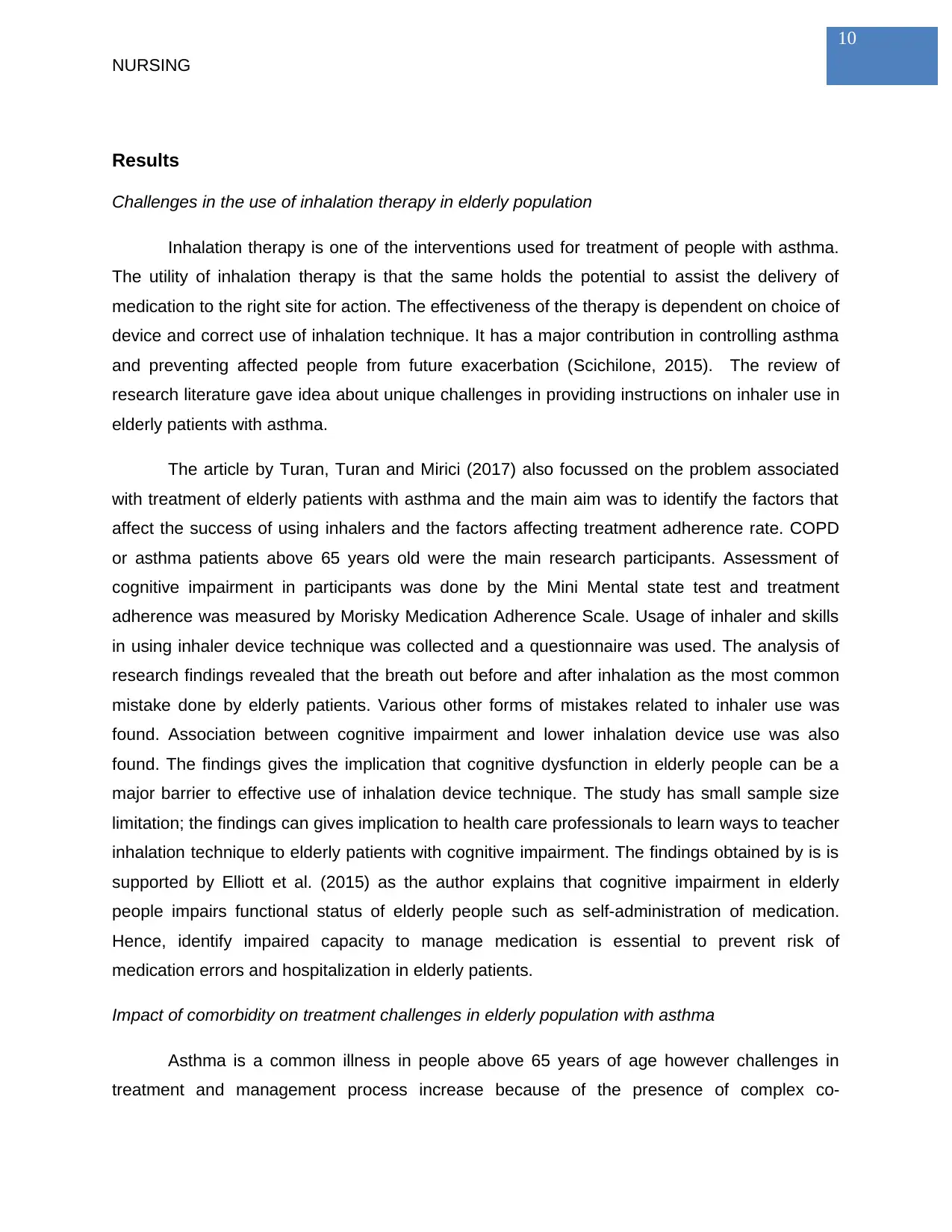
10
NURSING
Results
Challenges in the use of inhalation therapy in elderly population
Inhalation therapy is one of the interventions used for treatment of people with asthma.
The utility of inhalation therapy is that the same holds the potential to assist the delivery of
medication to the right site for action. The effectiveness of the therapy is dependent on choice of
device and correct use of inhalation technique. It has a major contribution in controlling asthma
and preventing affected people from future exacerbation (Scichilone, 2015). The review of
research literature gave idea about unique challenges in providing instructions on inhaler use in
elderly patients with asthma.
The article by Turan, Turan and Mirici (2017) also focussed on the problem associated
with treatment of elderly patients with asthma and the main aim was to identify the factors that
affect the success of using inhalers and the factors affecting treatment adherence rate. COPD
or asthma patients above 65 years old were the main research participants. Assessment of
cognitive impairment in participants was done by the Mini Mental state test and treatment
adherence was measured by Morisky Medication Adherence Scale. Usage of inhaler and skills
in using inhaler device technique was collected and a questionnaire was used. The analysis of
research findings revealed that the breath out before and after inhalation as the most common
mistake done by elderly patients. Various other forms of mistakes related to inhaler use was
found. Association between cognitive impairment and lower inhalation device use was also
found. The findings gives the implication that cognitive dysfunction in elderly people can be a
major barrier to effective use of inhalation device technique. The study has small sample size
limitation; the findings can gives implication to health care professionals to learn ways to teacher
inhalation technique to elderly patients with cognitive impairment. The findings obtained by is is
supported by Elliott et al. (2015) as the author explains that cognitive impairment in elderly
people impairs functional status of elderly people such as self-administration of medication.
Hence, identify impaired capacity to manage medication is essential to prevent risk of
medication errors and hospitalization in elderly patients.
Impact of comorbidity on treatment challenges in elderly population with asthma
Asthma is a common illness in people above 65 years of age however challenges in
treatment and management process increase because of the presence of complex co-
NURSING
Results
Challenges in the use of inhalation therapy in elderly population
Inhalation therapy is one of the interventions used for treatment of people with asthma.
The utility of inhalation therapy is that the same holds the potential to assist the delivery of
medication to the right site for action. The effectiveness of the therapy is dependent on choice of
device and correct use of inhalation technique. It has a major contribution in controlling asthma
and preventing affected people from future exacerbation (Scichilone, 2015). The review of
research literature gave idea about unique challenges in providing instructions on inhaler use in
elderly patients with asthma.
The article by Turan, Turan and Mirici (2017) also focussed on the problem associated
with treatment of elderly patients with asthma and the main aim was to identify the factors that
affect the success of using inhalers and the factors affecting treatment adherence rate. COPD
or asthma patients above 65 years old were the main research participants. Assessment of
cognitive impairment in participants was done by the Mini Mental state test and treatment
adherence was measured by Morisky Medication Adherence Scale. Usage of inhaler and skills
in using inhaler device technique was collected and a questionnaire was used. The analysis of
research findings revealed that the breath out before and after inhalation as the most common
mistake done by elderly patients. Various other forms of mistakes related to inhaler use was
found. Association between cognitive impairment and lower inhalation device use was also
found. The findings gives the implication that cognitive dysfunction in elderly people can be a
major barrier to effective use of inhalation device technique. The study has small sample size
limitation; the findings can gives implication to health care professionals to learn ways to teacher
inhalation technique to elderly patients with cognitive impairment. The findings obtained by is is
supported by Elliott et al. (2015) as the author explains that cognitive impairment in elderly
people impairs functional status of elderly people such as self-administration of medication.
Hence, identify impaired capacity to manage medication is essential to prevent risk of
medication errors and hospitalization in elderly patients.
Impact of comorbidity on treatment challenges in elderly population with asthma
Asthma is a common illness in people above 65 years of age however challenges in
treatment and management process increase because of the presence of complex co-
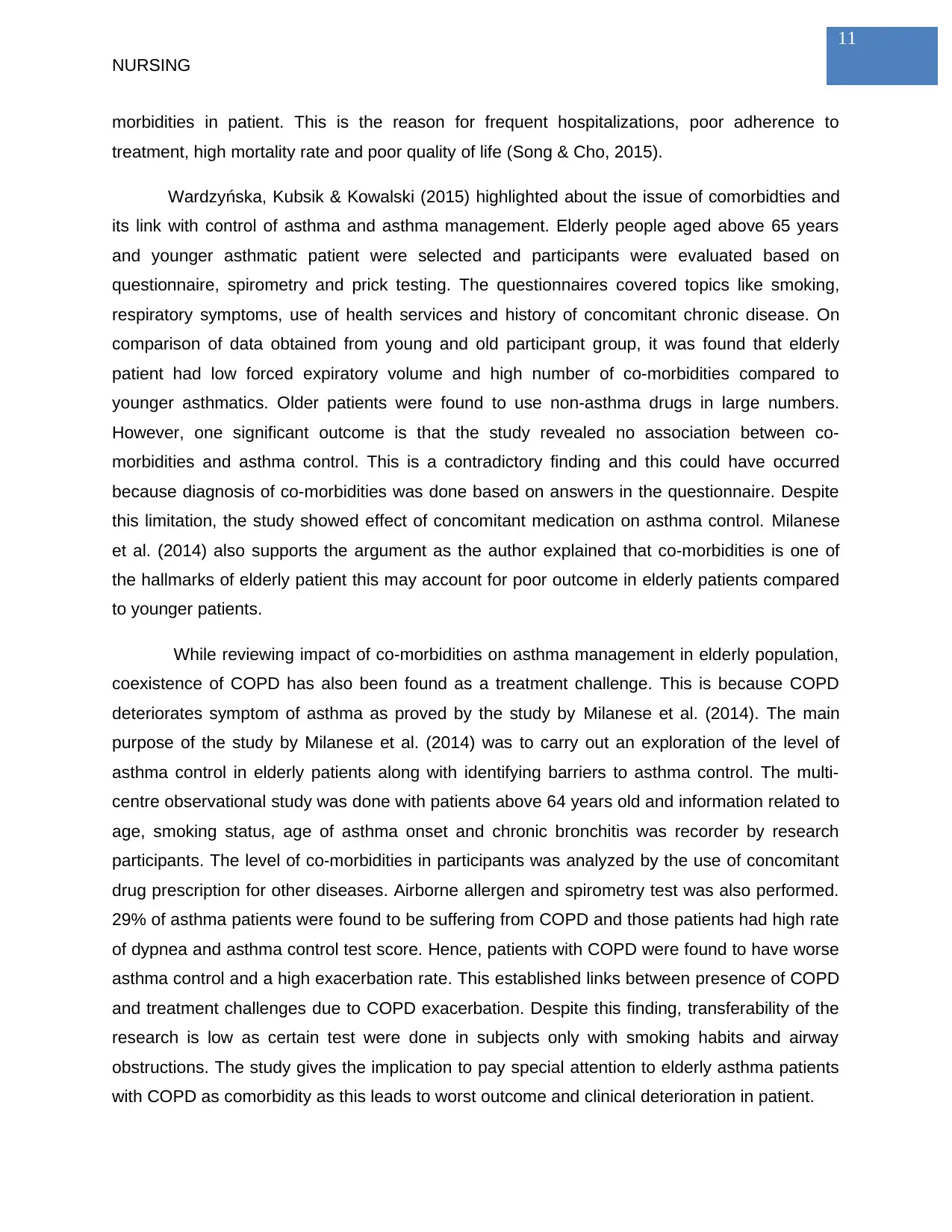
11
NURSING
morbidities in patient. This is the reason for frequent hospitalizations, poor adherence to
treatment, high mortality rate and poor quality of life (Song & Cho, 2015).
Wardzyńska, Kubsik & Kowalski (2015) highlighted about the issue of comorbidties and
its link with control of asthma and asthma management. Elderly people aged above 65 years
and younger asthmatic patient were selected and participants were evaluated based on
questionnaire, spirometry and prick testing. The questionnaires covered topics like smoking,
respiratory symptoms, use of health services and history of concomitant chronic disease. On
comparison of data obtained from young and old participant group, it was found that elderly
patient had low forced expiratory volume and high number of co-morbidities compared to
younger asthmatics. Older patients were found to use non-asthma drugs in large numbers.
However, one significant outcome is that the study revealed no association between co-
morbidities and asthma control. This is a contradictory finding and this could have occurred
because diagnosis of co-morbidities was done based on answers in the questionnaire. Despite
this limitation, the study showed effect of concomitant medication on asthma control. Milanese
et al. (2014) also supports the argument as the author explained that co-morbidities is one of
the hallmarks of elderly patient this may account for poor outcome in elderly patients compared
to younger patients.
While reviewing impact of co-morbidities on asthma management in elderly population,
coexistence of COPD has also been found as a treatment challenge. This is because COPD
deteriorates symptom of asthma as proved by the study by Milanese et al. (2014). The main
purpose of the study by Milanese et al. (2014) was to carry out an exploration of the level of
asthma control in elderly patients along with identifying barriers to asthma control. The multi-
centre observational study was done with patients above 64 years old and information related to
age, smoking status, age of asthma onset and chronic bronchitis was recorder by research
participants. The level of co-morbidities in participants was analyzed by the use of concomitant
drug prescription for other diseases. Airborne allergen and spirometry test was also performed.
29% of asthma patients were found to be suffering from COPD and those patients had high rate
of dypnea and asthma control test score. Hence, patients with COPD were found to have worse
asthma control and a high exacerbation rate. This established links between presence of COPD
and treatment challenges due to COPD exacerbation. Despite this finding, transferability of the
research is low as certain test were done in subjects only with smoking habits and airway
obstructions. The study gives the implication to pay special attention to elderly asthma patients
with COPD as comorbidity as this leads to worst outcome and clinical deterioration in patient.
NURSING
morbidities in patient. This is the reason for frequent hospitalizations, poor adherence to
treatment, high mortality rate and poor quality of life (Song & Cho, 2015).
Wardzyńska, Kubsik & Kowalski (2015) highlighted about the issue of comorbidties and
its link with control of asthma and asthma management. Elderly people aged above 65 years
and younger asthmatic patient were selected and participants were evaluated based on
questionnaire, spirometry and prick testing. The questionnaires covered topics like smoking,
respiratory symptoms, use of health services and history of concomitant chronic disease. On
comparison of data obtained from young and old participant group, it was found that elderly
patient had low forced expiratory volume and high number of co-morbidities compared to
younger asthmatics. Older patients were found to use non-asthma drugs in large numbers.
However, one significant outcome is that the study revealed no association between co-
morbidities and asthma control. This is a contradictory finding and this could have occurred
because diagnosis of co-morbidities was done based on answers in the questionnaire. Despite
this limitation, the study showed effect of concomitant medication on asthma control. Milanese
et al. (2014) also supports the argument as the author explained that co-morbidities is one of
the hallmarks of elderly patient this may account for poor outcome in elderly patients compared
to younger patients.
While reviewing impact of co-morbidities on asthma management in elderly population,
coexistence of COPD has also been found as a treatment challenge. This is because COPD
deteriorates symptom of asthma as proved by the study by Milanese et al. (2014). The main
purpose of the study by Milanese et al. (2014) was to carry out an exploration of the level of
asthma control in elderly patients along with identifying barriers to asthma control. The multi-
centre observational study was done with patients above 64 years old and information related to
age, smoking status, age of asthma onset and chronic bronchitis was recorder by research
participants. The level of co-morbidities in participants was analyzed by the use of concomitant
drug prescription for other diseases. Airborne allergen and spirometry test was also performed.
29% of asthma patients were found to be suffering from COPD and those patients had high rate
of dypnea and asthma control test score. Hence, patients with COPD were found to have worse
asthma control and a high exacerbation rate. This established links between presence of COPD
and treatment challenges due to COPD exacerbation. Despite this finding, transferability of the
research is low as certain test were done in subjects only with smoking habits and airway
obstructions. The study gives the implication to pay special attention to elderly asthma patients
with COPD as comorbidity as this leads to worst outcome and clinical deterioration in patient.
⊘ This is a preview!⊘
Do you want full access?
Subscribe today to unlock all pages.

Trusted by 1+ million students worldwide
1 out of 38
Related Documents
Your All-in-One AI-Powered Toolkit for Academic Success.
+13062052269
info@desklib.com
Available 24*7 on WhatsApp / Email
![[object Object]](/_next/static/media/star-bottom.7253800d.svg)
Unlock your academic potential
Copyright © 2020–2025 A2Z Services. All Rights Reserved. Developed and managed by ZUCOL.





